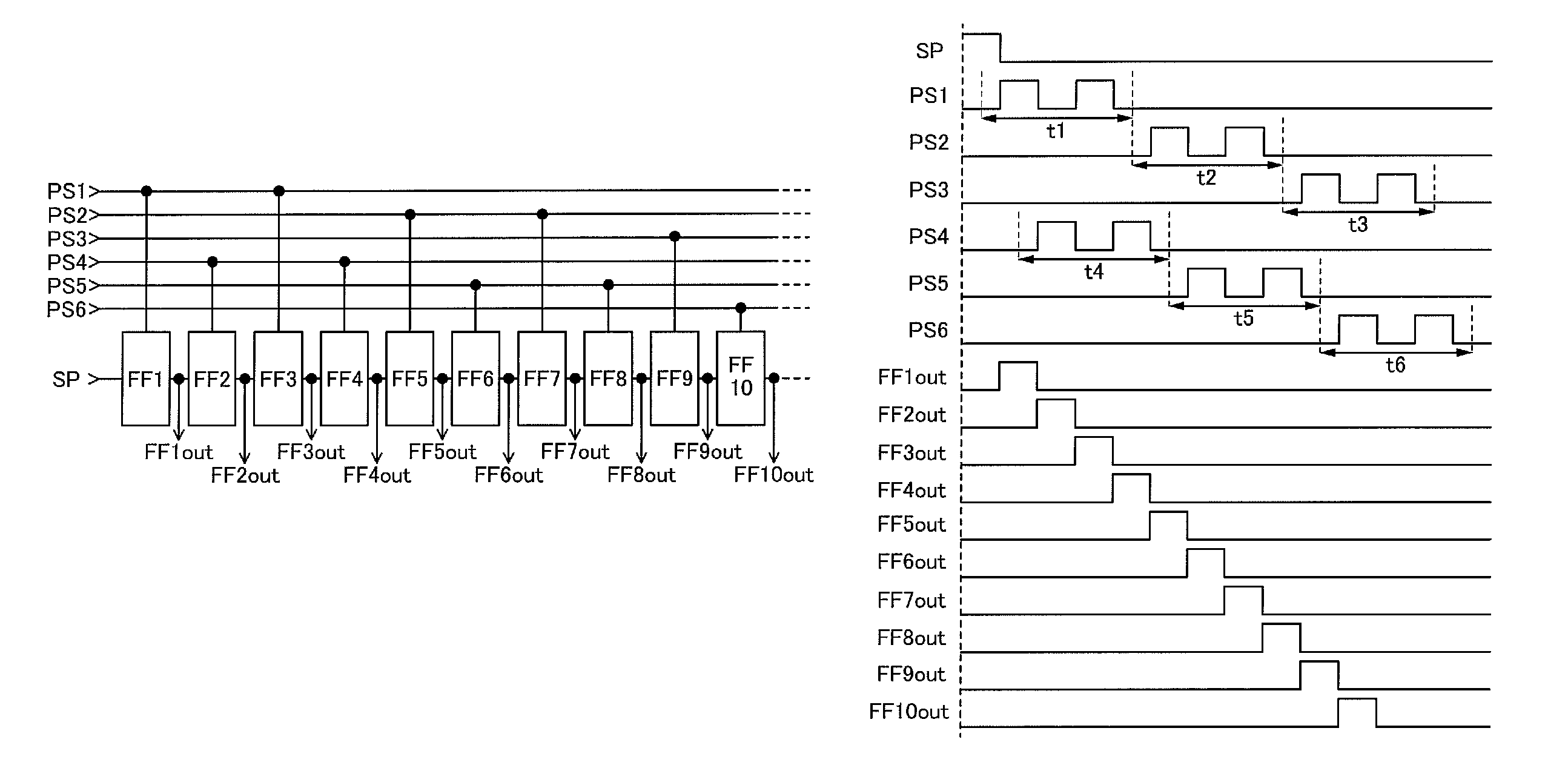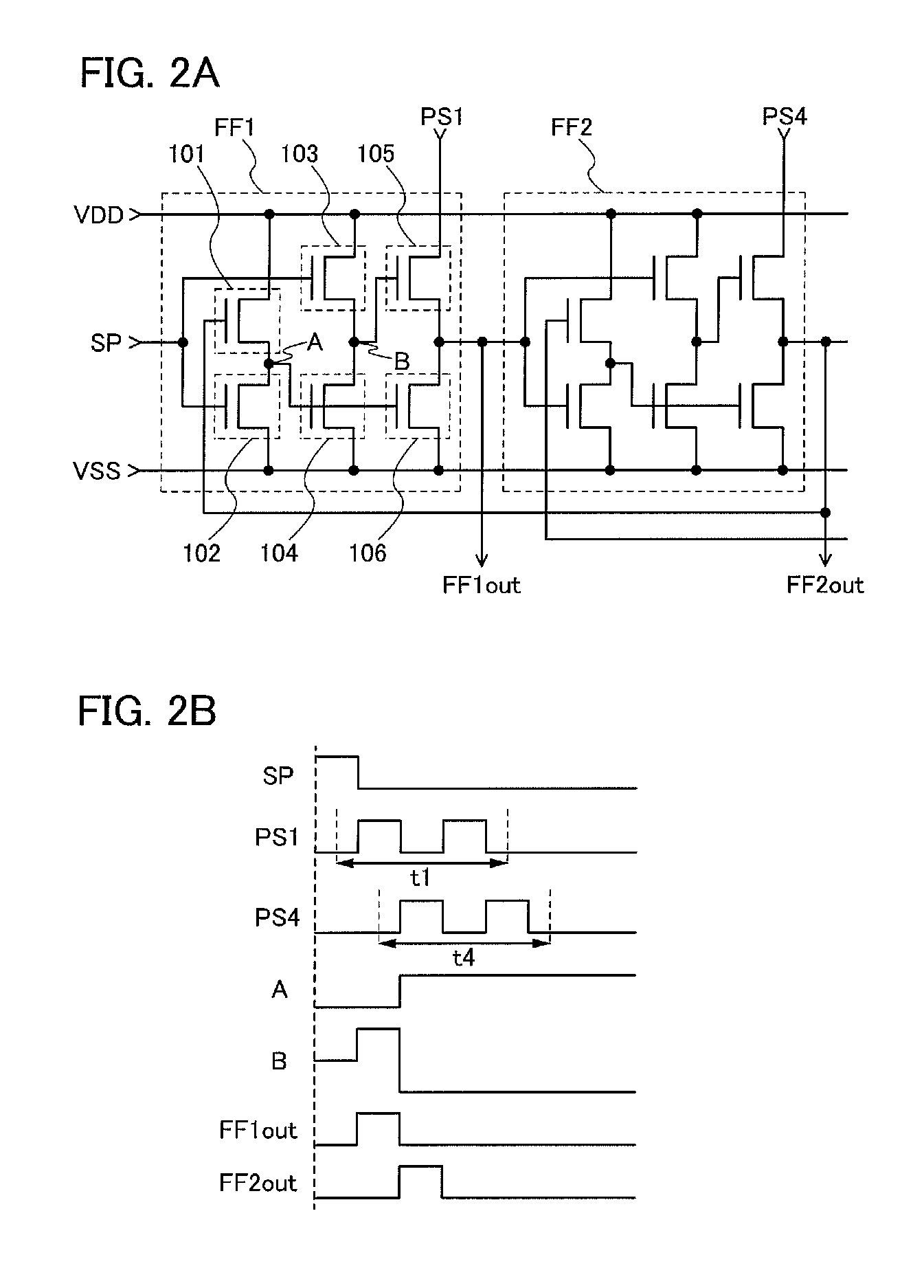Shift register and display device and driving method thereof
a shift register and display device technology, applied in semiconductor devices, digital storage, instruments, etc., can solve the problems of power consumption of clock signals inputted to the driver circuit, the gate width of a tft included in the driver circuit needs to be increased, and the signal decreases or increases the same amount as the threshold voltage of the tft, so as to reduce the load caused by clock signals and reduce the power consumption of the shift register.
- Summary
- Abstract
- Description
- Claims
- Application Information
AI Technical Summary
Benefits of technology
Problems solved by technology
Method used
Image
Examples
embodiment 1
[0047]In this embodiment, examples of a structure and operation of a shift register are described with reference to FIGS. 1A and 1B, FIGS. 2A and 2B, FIGS. 3A and 3B, FIGS. 4A and 4B, FIGS. 5A to 5C, FIGS. 6A to 6C, and FIGS. 7A and 7B. Specifically, a shift register which includes a pulse signal line and a flip-flop is described. The pulse signal line serves as a wiring for supplying a clock signal in part of the operation period of the shift register and serves as a wiring for supplying a low power supply potential in the other periods. The flip-flop is electrically connected to the pulse signal line.
[0048]A shift register in this embodiment includes first to sixth pulse signal lines and first to tenth flip-flops.
[0049]The first pulse signal line (PS1) is electrically connected to the first flip-flop (FF1) and the third flip-flop (FF3). The second pulse signal line (PS2) is electrically connected to the fifth flip-flop (FF5) and the seventh flip-flop (FF7). The third pulse signal ...
embodiment 2
[0110]In this embodiment, an example of a transistor which is applicable to the shift register described in Embodiment 1 will be described.
[0111]Examples of structures of the transistors of this embodiment will be described with reference to FIGS. 8A to 8C. FIGS. 8A to 8C illustrate examples of the structures of the transistors of this embodiment. FIG. 8A is a top diagram and FIG. 8B is a cross-sectional diagram taken along line Z1-Z2 in FIG. 8A.
[0112]The transistor in FIGS. 8A and 8B includes a conductive layer 211 over a substrate 201, an insulating layer 202 over the conductive layer 211, an oxide semiconductor layer 213 over the insulating layer 202, and a conductive layer 215a and a conductive layer 215b over the oxide semiconductor layer 213.
[0113]Note that in the transistor, the conductive layer 211 serves as a gate terminal, the insulating layer 202 serves as a gate insulating layer, one of the conductive layers 215a and 215b serves as a source terminal, and the other of the...
embodiment 3
[0181]In this embodiment, another example of a transistor which is applicable to the shift register described in Embodiment 1 and different from the transistor described in Embodiment 2 will be described.
[0182]An example of a structure of the transistor of this embodiment will be described with reference to FIGS. 12A and 12B. FIGS. 12A and 12B illustrate an example of a structure of the transistor of this embodiment. FIG. 12A is a top diagram of the transistor and FIG. 12B is a cross-sectional diagram taken along line Z1-Z2 in FIG. 12A.
[0183]The transistor illustrated in FIGS. 12A and 12B includes the conductive layer 211 over the substrate 201; the insulating layer 202 over the conductive layer 211; the conductive layers 215a and 215b over the insulating layer 202; the oxide semiconductor layer 213 over the insulating layer 202 and the conductive layers 215a and 215b.
[0184]In the transistor, the conductive layer 211 serves as a gate terminal, the insulating layer 202 serves as a g...
PUM
 Login to View More
Login to View More Abstract
Description
Claims
Application Information
 Login to View More
Login to View More - R&D
- Intellectual Property
- Life Sciences
- Materials
- Tech Scout
- Unparalleled Data Quality
- Higher Quality Content
- 60% Fewer Hallucinations
Browse by: Latest US Patents, China's latest patents, Technical Efficacy Thesaurus, Application Domain, Technology Topic, Popular Technical Reports.
© 2025 PatSnap. All rights reserved.Legal|Privacy policy|Modern Slavery Act Transparency Statement|Sitemap|About US| Contact US: help@patsnap.com



